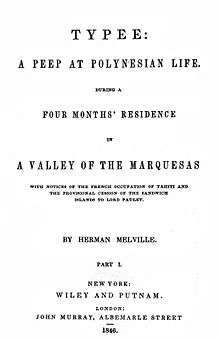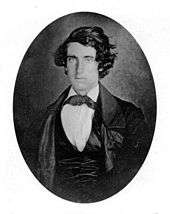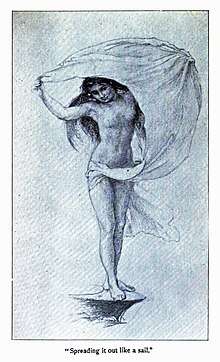Typee
Typee: A Peep at Polynesian Life is the first book by American writer Herman Melville, published first in London, then New York, in 1846. Considered a classic in travel and adventure literature, the narrative is partly based on the author's actual experiences on the island Nuku Hiva in the South Pacific Marquesas Islands in 1842, liberally supplemented with imaginative reconstruction and adaptation of material from other books. The title comes from the valley of Taipivai, once known as Taipi.[1] Typee was Melville's most popular work during his lifetime; it made him notorious as the "man who lived among the cannibals".[2]
 First American edition title page | |
| Author | Herman Melville |
|---|---|
| Country | United States, England |
| Language | English |
| Genre | Travel literature |
| Published |
|
| Media type | |
| Followed by | Omoo |
Background

The book presents itself as a piece of travel adventure, but from the beginning there were questions whether the story was true. The London edition of the book appeared in the publisher John Murray's Colonial and Home Library series, accounts of foreigners in exotic places, and the slightly suspicious Murray required reassurance that Melville's experiences was first-hand, not the work of a professional travel writer, and that the author had himself experienced the adventures he described. American readers, however, accepted the story at face value.[3]
Typee is, "in fact, neither literal autobiography nor pure fiction," says scholar Leon Howard. Melville "drew his material from his experiences, from his imagination, and from a variety of travel books when the memory of his experiences were inadequate."[2] He departed from what actually happened in several ways, sometimes by extending factual incidents, sometimes by fabricating them, and sometimes by what one scholar calls "outright lies".[4]
The actual one-month stay on which Typee is based is presented as four months in the narrative; there is no lake on the actual island on which Melville might have canoed with the lovely Fayaway, and the ridge which Melville describes climbing after escaping the ship he may actually have seen in an engraving. He drew extensively on contemporary accounts by Pacific explorers to add to what might otherwise have been a straightforward story of escape, capture, and re-escape. Most American reviewers accepted the story as authentic, though it provoked disbelief among some British readers.
Two years after the novel's publication, many of the events described therein were corroborated by Melville's fellow castaway, Richard Tobias "Toby" Greene.[2]
Critical response

Typee's narrative expresses sympathy for the so-called savage natives, while criticizing the missionaries' attempts to civilize them:
It may be asserted without fear of contradictions that in all the cases of outrages committed by Polynesians, Europeans have at some time or other been the aggressors, and that the cruel and bloodthirsty disposition of some of the islanders is mainly to be ascribed to the influence of such examples.
[The] voluptuous Indian, with every desire supplied, whom Providence has bountifully provided with all the sources of pure and natural enjoyment, and from whom are removed so many of the ills and pains of life—what has he to desire at the hands of Civilization? Will he be the happier? Let the once smiling and populous Hawaiian islands, with their now diseased, starving, and dying natives, answer the question. The missionaries may seek to disguise the matter as they will, but the facts are incontrovertible. CH 4
The narrator states that Typee natives ate an inhabitant of one of the neighboring valleys, but the natives who captured him reassured him that he would not be eaten.
The Knickerbocker called Typee "a piece of Münchhausenism".[5] New York publisher Evert Augustus Duyckinck wrote to Nathaniel Hawthorne that "it is a lively and pleasant book, not over philosophical perhaps."[6] In 1939 Charles Robert Anderson published Melville in the South Seas [7] in which he documented that Melville had spent only one month on the island (rather than the four months he claimed) and that Melville lifted extensive material from travel narratives.[8]
Publication history
Typee was published first in London by John Murray on February 26, 1846, and then in New York by Wiley and Putnam on March 17, 1846.[9] It was Melville's first book, and made him one of the best-known American authors overnight.[10]
The same version was published in London and New York in the first edition; however, Melville removed critical references to missionaries and Christianity from the second U.S. edition at the request of his American publisher. Later additions included a "Sequel: The Story of Toby" written by Melville, explaining what happened to Toby.[11]
Before Typee's publication in New York, Wiley and Putnam asked Melville to remove one sentence. In a scene where the Dolly is boarded by young women from Nukuheva, Melville originally wrote:
Our ship was now given up to every species of riot and debauchery. Not the feeblest barrier was interposed between the unholy passions of the crew and their unlimited gratification.
The second sentence was removed from the final version.[12]
The inaugural book of the Library of America series, titled Typee, Omoo, Mardi (May 6, 1982), was a volume containing Typee: A Peep at Polynesian Life, its sequel Omoo: A Narrative of Adventures in the South Seas (1847), and Mardi, and a Voyage Thither (1849).[13]
See also
- Last of the Pagans, a 1935 film adaptation of Typee
- Enchanted Island, a 1958 film adaptation of Typee
References
- Christian, F.W., Nuku and Uia-Ei, 1895, "Notes on the Marquesans," Journal of the Polynesian Society 4(3):187-202. Page 200
- Howard (1968), p. 291-294.
- Howard (1968), p. 279.
- Herbert (1980), p. 159.
- Miller (1956), 203.
- Widmer (1999), 108
- Charles Roberts Anderson. Melville in the South Seas. (New York: Columbia University Press Columbia University Studies in English and Comparative Literature, No. 138, 1939).
- Koy (2017), 35.
- Howard (1968), p. 285.
- Miller (1956), 4
- Melville, Herman (2013). Delphi Complete Works of Herman Melville (Illustrated). https://books.google.com/books?id=mtsZAgAAQBAJ&dq=Delphi+Complete+Works+of+Herman+Melville+(Illustrated): Delphi Classics. ISBN 1908909587 – via books.google.com.
- Nelson (1981), 187
- Melville, Herman (1982). Typee, Omoo, Mardi (Library of America ed.). G. Thomas Tanselle. ISBN 978-0-940450-00-4.
Bibliography
- Herbert, T. Walter (1980). Marquesan Encounters: Melville and the Meaning of Civilization. Cambridge, MA: Harvard University Press. ISBN 0674550668.CS1 maint: ref=harv (link)
- Howard, Leon (1968), "Historical Note", in Melville, Herman (ed.), Typee: A Peep at Polynesian Life the Writings of Herman Melville Vol. 1, Evanston, IL: Northwestern University Press, pp. 277–302, ISBN 9780810101593CS1 maint: ref=harv (link)
- Koy, Christopher (November 2017). "Plagiarism in Typee: A Peep at Herman Melville's Lifting from Travel Narratives". British and American Studies Annual. 10: 33–45.
- Melville, Herman (1968). Typee: A Peep at Polynesian Life. 1. Evanston, IL: Northwestern University Press. ISBN 9780810101593.
- Miller, Perry. (1956). The Raven and the Whale: The War of Words and Wits in the Era of Poe and Melville. New York: Harvest Book.
- Nelson, Randy F. (1981). The Almanac of American Letters. Los Altos, California: William Kaufmann, Inc. ISBN 0-86576-008-X
- Widmer, Edward L. (1999). Young America: The Flowering of Democracy in New York City. New York: Oxford University Press. ISBN 0-19-514062-1
External links
| Wikisource has original text related to this article: |
- Typee at Project Gutenberg
- Typee, 1846 first edition, scanned book via Internet Archive, other later editions available.

- Typee, Fluid Text Edition at the University of Virginia Press
- The Classics Illustrated comic book at the Internet Archive